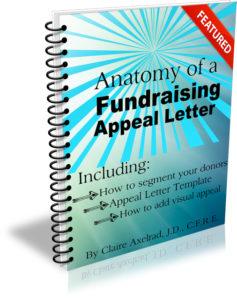 Have you ever found yourself, whether by accident or design, face-to-face with a VIP – a Very Important Prospect – and been at a loss for the right words to convey what you do?
Have you ever found yourself, whether by accident or design, face-to-face with a VIP – a Very Important Prospect – and been at a loss for the right words to convey what you do?
It used to happen to me all the time. I’d run into someone at a cocktail party and find out they’re the program officer for a corporate foundation. Or I’d meet someone at an event who I knew was a major philanthropist to other charities in our community. Or I’d plan a prospect visit, and right away be asked: “Tell me a bit about what you do, and what your biggest challenges are?”
When this happens, what do you say?
All too often, you awkwardly spit out a canned, memorized elevator pitch.
Perhaps something like: “We’re a comprehensive human services agency. Founded in 1850. We help 75,000 people of all ages in five counties. We focus on the underserved.”
Are your eyeballs rolling back into their sockets?
There’s a story – many stories – hiding in there somewhere.
Why is it that most of us don’t tell our story when given the opportunity? A story is much more compelling than dry facts and figures. And you don’t have to “pitch” it.
A Good Story Pitches Itself!
So, let’s free up your stories, and get you out of the elevator.
Traditional “elevator pitch” elements include:
- How you began; why you exist.
- The problem(s) you solve.
- Your impact.
- How you’re distinct from others in your field.
- Why people should care.
- Why you are the best solution.
- What you need most right now.
Not necessarily bad, particularly if you’re writing a grant proposal. But, for most people, this is too much (TMI). Plus, this structure tends to lead with dry facts and figures.
Rather than stringing these “pitch” elements together as a bunch of data, try telling an emotional tale.
You’ll be amazed at how these elements naturally fall into place — and come alive!
Begin with Your Personal Connection to the Vision and Mission
You should be passionate about the story you tell. Passion is contagious.
To ignite personal passions, I ask board members to tell me why they became involved, and stay involved. I’ve never had anyone say “because we serve 75,000 people.” It’s usually something personal like:
- “My mother and sister had breast cancer,” or
- “I grew up hungry,” or
- “I was fortunate to attend this school on a scholarship,” or
- “The play moved me so much, I just wanted to say thank you,” or
- “Seeing families being torn apart broke my heart,” or
- “I saw the story about the abandoned kittens, and I just couldn’t ignore it.”
When folks remind themselves why they care (and this includes staff and board), they come back to the fire in the belly that connected them.
This is the fire needed to connect others.
Capture Fire-in-the-Belly in a Story
Everyone loves a good story. Everyone. And it comes much easier to folks than trying to memorize a canned elevator pitch. You’ll find if you practice it, storytelling comes naturally. Our brains are wired to tell stories. It’s the oldest form of human communication.
We’re used to a natural storytelling arc.
It moves from a difficult situation… to a trigger that makes this situation urgent… to a character/protagonist who, encountering the situation, goes on a journey to overcome the trials and tribulations … to a mission [yours] and how this can positively impact the story… to an invitation to become a hero who saves the day. [NOTE: Saving the day doesn’t have to translate to “donor as savior.” It can simply mean empowering beneficiaries to fight the fight and come out as winners.]
A Heartfelt, Emotional Story Looks Something Like This
Once upon a time…
- There was this untenable, unfortunate, unbelievable situation …
- Every day, our protagonist (the person, animal or cause you want to help) faced many obstacles…
- One day our protagonist battled to overcome these obstacles, but sadly…
- Because of that [your organization] stepped in to provide…
- What was most needed…
- But the happy ending has eluded the protagonist this far.
- A hero or, if you will, a hopeful partner is being sought to help the protagonist fight the oppressor.
- Finally… [what donor can do, with black and white specificity, to make something good or bad happen].
EXAMPLE: I remember a hospital board member who told me her daughter’s finger was severed, then reattached, by a doctor who wouldn’t take no for an answer. Here’s how she turned this event into a compelling story showing the role played by the organization and donors, working together:
“Once upon a time… my daughter lost her finger [unfortunate situation] in an accident with a slamming car door. The local hospital said they couldn’t reattach it [obstacle]. My daughter was inconsolable! Playing piano and sports were what she lived for [why obstacle untenable]. I called my doctor, who put us in touch with this hospital for a second opinion… long story short, because this hospital had state-of-the-art equipment and the best surgeons money can buy (all due to philanthropy) [donors saved the day], they attached her finger [what was most urgently needed right now] and she’s now living happily ever after!
Develop a Practice of Collecting and Telling Stories
Board and staff alike should be able to weave together both (1) their own personal story/passion, and (2) a story about the impact your nonprofit has – the people, animals, places or things that are helped – due to philanthropy.
This means developing a true storytelling culture, which I discuss in 6 Best Ways to Make Storytelling Part of Your Nonprofit Culture.
As business and thought leader Jim Collins taught us:
“We are known by the stories we can tell.”
Do you have some that come to mind? If so, use them! If not, you’ve got your homework.
Get Your Story on the Best Seller List
Let’s face it. Donors have lots of stories to choose from. So why choose yours? This gets back to the final elements of the traditional elevator pitch: (1) “Why you?” and (2) “What do you need most right now?”
Folks want to know what is most urgent, because there are many deserving causes all competing for their philanthropy. They want to give where it will make the greatest impact. And where they’ll get the biggest bank for their buck.
Can you blame them?
Tell folks why they should choose you.
You’ve got to show folks they’ll get the biggest bang for their buck with you. Not simply “we’re the oldest or the biggest” but “all our staff are survivors; they know how to work with this population.” Or “we have the most Nobel Prize winners; we’re likely to find the cure faster.”
Tell folks why it’s urgent.
I’ve been on visits with board members and E.D.s who couldn’t answer this critical question. They’d stammer out “Oh, everything is important” or “Whatever you choose to give to will be appreciated.” That’s nice, if you want a token gift. It’s definitely not passionate or inspiring.
If you want your story to rise to the top of your prospective donor’s philanthropy list, you’ve got to create urgency and be crystal clear what you need (dollar amount) and what that gift will accomplish (amazing happy ending).
EXAMPLE: There’s a huge difference between “We need money to help poor Holocaust survivors” and a compelling narrative, with all the elements a good story should have, that concludes with a specific ask and urgency:
“Now in the final chapter of their lives, because of all they endured, many suffer from illness and have unique medical and psychological needs as a result of the profound trauma they experienced. We have a waiting list of 300 survivors – most in their 90’s and older – for whom targeted support is needed now, while the need is acute and intensifying, to build an Emergency Assistance Fund. We’re seeking $500,000 to provide the special care they need for food, shelter, safety, physical and mental health.”
Your nonprofit will be known by – and will live and die by – the stories you can tell.
See The Power of Storytelling for Nonprofits, a panel hosted by NXUnite in which I participated with fellow panelists Patrick Rafferty, Kristen Steele, and Dave Norris. The first question asked is “How have you seen expectations and best practices change for storytelling?” I’m up first for that question, and talk about what raises the most money and how this sometimes raises ethical dilemmas. There’s a lot of food for thought if you listen to the entire panel. And this is just one of the questions addressed!
How much more could you raise with your appeal if it spoke straight to the heart – and to your donor’s passions?

This 62-page e-Guide is a surprisingly quick read — and a true road map to creating a winning fundraising appeal
If you’re wondering, grab my Anatomy of a Fundraising Appeal Letter plus Sample Template. This step-by-step guide to crafting a killer appeal letter or email appeal will help you take your appeal from colorless to captivating. I guarantee you’ll raise more money if you follow the blueprint outline in this guide.
As with all Clairification products, if you’re not happy for any reason you have my 30-day, no-questions-asked, 100% refund guarantee.
Photo by Osmar do Canto on Unsplash





